M3 "Stewart": the most massive light tank in history
The prehistory of the appearance of the tank M3
By the beginning of World War II, the US Army had two types of light tanks. The infantry units were armed with 292 tank modifications M2A2 and M2AZ. These were double-turreted tanks with machine-gun armaments, with 12,7-mm in one and with 7,62-mm machine gun in another turret. Along with them in the ranks of the motorized cavalry units there were 112 tanks М1 and М1А1. In these tanks, exactly the same machine gun weapons were located in the same turret. Structurally, such tanks had the same chassis, which was applied to each board of 4-x track rollers. Interlocked in pairs with each other in two balancing trolleys, support rollers were suspended on vertical buffer springs. That chassis was, perhaps, the main advantage of anything not particularly remarkable, but by the time of the start of the Second World War and an order of obsolete tanks. But the performance of the chassis is really amazing. In November, the 1934 of the year, the T5 tank, which was the prototype of the M1, successfully completed a test run from the Rock Island arsenal to Washington with a total length of 1450 kilometers. During the run, the average speed of the tank was 48 km / h. Launched from the Rock Island 14 arsenal in November, the tank crew arrived in Washington after 3 of the day, thus breaking all speed records for tracked vehicles. In the future, this undercarriage design was used on all American-made tanks up to the 1945 of the year.
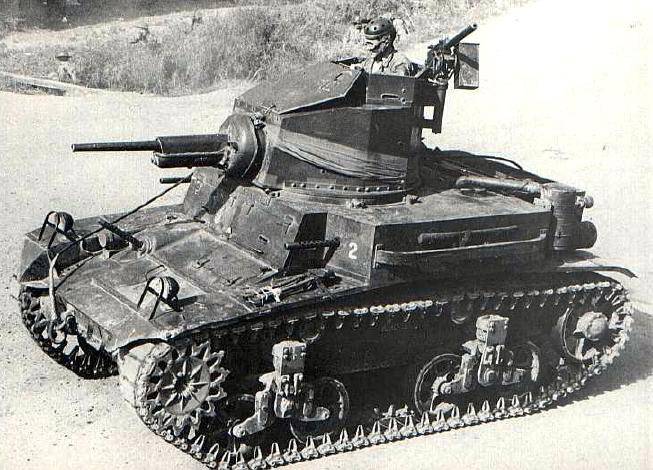
The fighting, which began in Europe 1 September 1939, quickly demonstrated to the American generals the futility of exclusively machine guns, which forced them to speed up the design work on the creation of a new light tank equipped with artillery weapons. Thus, the M2А4 tank was born. The first light tanks of this type left the assembly line of the American Car and Foundry plant in May 1940. The release of combat vehicle data was completed in March of the 1941 of the year, a total of 365 tanks of this type were collected. Another 10 tanks in April, the company Baldwin Lokomotiv Works produced 1942 of the year. М2А4 combined the features of both pre-war American tanks (archaic for 1940 of the year, for example, were 5 primitive inspection hatches located along the perimeter of the tower), and light tanks of the Second World War period. Without leaving any noticeable trace in the history of tank building, the light tank М2А4 became a very important milestone in the history of the American army. With the advent of the tank in the US troops coincided with the formation of tank divisions. 15 July 1940 in the United States began the formation of the 1 and 2 armored divisions, which received the new light tanks М2А4.
At the same time, light tanks М2А4 were initially used mainly for training purposes. In the battle, these vehicles happened to be visited only once - this happened at the end of 1942 on the island of Guadalcanal in the Pacific Ocean, where they fought with the Japanese as part of the 1 tank corps battalion. Another 4 of such a tank on the program Lend-Lease received the UK. At the same time, soon after the release of the first M2А4 tanks in the USA, the design of an improved version of this combat vehicle began. In particular, the thickness of the frontal armor of the turret and the hull of the tank increased, which resulted in the growth of the mass of the combat vehicle to 12 tons. At the same time, in order to at least somehow reduce the specific pressure, the sloth was decided to be put on the ground. This decision of the American engineers has increased the stability of the tank. For a more reliable protection of the engine, the tank hull aft part was subjected to alteration. The first prototype of the new light tank was created on the basis of the M2А4 in the Rock Island arsenal, and already on July 5 of the year 1940 it was put into service under the designation “Light tank М3”. The first serial tanks M3 company "American Car and Foundry" produced in March 1941, immediately upon completion of the release of the tank M2A4.
Light tank M3
Structurally, the lightweight tank M3 "Stewart" repeated its predecessors, incorporating a number of shortcomings that were common to all American tanks of the 1930-ies. For example, the width of the tank was limited by the size of a standard American floating bridge of pre-war years. A short and high body did not allow to place in the tank turret an artillery system in caliber larger than 37 mm. Narrow tracks, which were borrowed from lighter tanks, caused a high specific pressure and limited combat capability of the combat vehicle on weak soils.
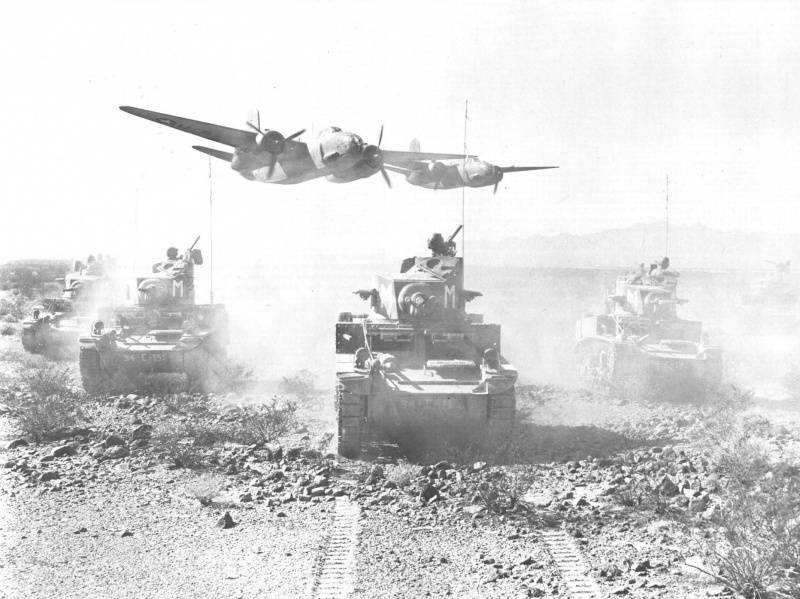
The main advantages of the light tank M3 include its very high operational reliability, as well as excellent dynamic performance. At the time of creation, the armament was also powerful enough to consist of an 37-mm M6 cannon and immediately five 7,62-mm Browning М1919А4 machine guns (one machine gun was paired with a gun was anti-aircraft).
During the serial production of a combat vehicle, changes were made to its design all the time, mainly of a technological nature. So, for example, a multi-faceted riveted turret on the machines of the first lots was replaced by a similar but welded turret, which was then replaced by the so-called "horseshoe-shaped" turret, the side walls of which were formed by one bent armor plate. On the late launch M3 tanks, the hull began to be assembled with partial use of welding. Starting from the second half of 1941, a stabilizer for pointing the 37-mm cannon in a vertical plane appeared on the light tank.
The hull of the lightweight M3 “Stewart” was made of rolled armor plates on the frame of the corners and strips with the help of riveting, while the later releases of the tanks were partially welded. The layout of the tank was as follows - with the rear engine and the front of the transmission units. The crew of the combat vehicle consisted of 4-man - a mechanic and his assistant (shooter), located in the office of control, as well as charging with the commander, who also served as a gunner, housed in a double tank turret.
The whole front sheet of the case of the turret box was occupied by the viewing windows of the driver and his assistant, these windows were completely closed with armor doors, which were folded up. Triplexes were installed in the doors. The viewing window of the mechanic-driver of the Stewart was docked with a rectangular hatch located in the upper front hull plate. The cover of this hatch was folded back and forth, which allowed the crew to land in the tank.
At the same time, only the seats of the tank driver and his assistant, who also served as the shooter from the course machine gun, were sufficiently comfortable. The seats of these two crew members had their backs, which were height adjustable and were even fitted with seat belts. Since the tower of the light tank М3 had no rotating polik, the loader and the gunner (he is the commander) did without seats at all. In the campaign, they were located on the sludge drawers with ammunition, the covers of which specifically had soft pillows, and in battle both served the gun in a standing position.
The main armament of the tank was 37-mm gun M6 with a barrel length 53,5 caliber. The initial speed of the armor-piercing projectile fired from this gun was 884 m / s. At a distance of 500 yards (457 meters), an armor-piercing projectile could penetrate homogeneous armor 53 mm thick, located at an angle 30 to the vertical; at a distance of 1000 yards (914 meters) - 46 mm and at a distance of 1500 yards (1327 meters) - 40 mm. Vertical aiming of the gun at the target was carried out in manual mode using the installed sector mechanism in the range from 100 to + 200. Rough horizontal guidance was also carried out in manual mode, with the flywheel located near the loader's place.
The 37-mm Browning М7,62-1919 machine gun was paired with the 4-mm gun. The total machine gun on the tank was 5. Another tank machine gun was installed in the ball mounting of the upper front hull plate. The fire out of it led the assistant driver. Two more “Browning” were placed in the side sponsons. The ability to adjust these machine guns in the horizontal and vertical plane was severely limited, in fact, the guidance was carried out by turning the hull of the tank. A tank mechanic (or a crew member who took his place) shot from these machine guns with the help of cables in Bowden sheath. The fifth 7,62-mm machine gun was anti-aircraft and was intended for firing at air targets, it was installed on board the tower just behind the commander's turret.
The undercarriage of the Stuart lightweight M3 tank (on each side) included 4 single rubberized road wheels, which were interlocked in pairs in two balance trolleys, which were suspended on two vertical buffer springs; 3 rubberized roller support; not rubberized guide wheel, which was also suspended on the buffer spring and equipped with a screw-type tensioning mechanism.
Light tank МХNUMX "Stuart" received its baptism of fire in North Africa and not under the American, but under the English flag. The defeat of the British troops on the continent and the loss of virtually 3 / 2 of their tanks, forced the British to seek help from their overseas ally. The British could not quickly make up for the losses they had incurred in tanks due to their own production. The first "Stuarts" Great Britain received in July 3, they entered service with the 1941 Royal Irish Hussars. By November of that year, all the 8 regiments of the 3 tank brigade were armed with American vehicles.
18 in November 1941 of the year in 8 kilometers from Gabr-Saleh The 8 th hussars and the 5 th royal armored regiments of this brigade met with the German thrusts 5. As a result of the ensuing tank battle, the British lost 11, the Germans 7 tanks (according to other sources, the outcome for the British was worse, 23 on 8). In December, 1941, the brigade was taken to the rear, which allowed to sum up some of the results of the use of American light tanks in combat conditions. It turned out that in two months of intense warfare in the desert from the 166 "Stuarts" of the 4 Tank Brigade, for technical reasons, only 12 machines failed. The British, who were constantly tormented by their very naughty tanks, were delighted with the "Stuart".
The third after the American and British armies by the number of Stuart tanks was the Red Army, which received 1232 light tanks of modifications M3 and M3A1: 972 tanks in 1942 and 255 in 1943 as part of the lend-lease program. In our country, these tanks called the M3 "light" or just M3l. At the same time, the Soviet tank crew never had a special success. Despite the excellent dynamic characteristics, the tank stood out for its large dimensions, which complicated camouflage. In addition, the tank worked on high-octane fuel that was scarce in the Soviet Union. It was necessary to fill in it aviation gasoline with an octane rating of at least 92, or in case of emergency, other gasoline, but with an octane rating of at least 82. In addition to all of the above, the tank required careful and regular maintenance, which was not in the tradition of Soviet zampotechs.
The main modifications of the tank:
M3. The very first modification of the tank, an option with a riveted hull and turret. In the process of serial production, the turret of the tank became welded, and its shape was changed from multi-faceted to horseshoe-shaped. Late-release tanks were distinguished by the presence of a partially welded hull. Part of the tanks was distinguished by the presence of a stabilizer aiming the gun in a vertical plane, as well as a diesel engine Guiberson T-1020-4 with 220 horsepower hp instead of the petrol power 250 hp. Total 5811 tanks were released M3.
MZA1. The version differs in that the commander's turret was eliminated on the tank, as well as machine guns placed in the airborne sponsors. The hull, chassis and power plant have not changed. A total of this type of 4621 tank was manufactured, of which 211 were equipped with a Guiberson T-1020-4 diesel engine.
M3A3. The version differed fully welded body, which received a new form with beveled cheekbones. The tower acquired a developed aft niche in which a radio station was installed. The armament, the undercarriage and the power plant are the same as those of the MZA1 tank. In total, the 3593 tank of this type was manufactured (taking into account the additional release).
M5. The version was distinguished by a new power plant, which consisted of two carburetor 8-cylinder engines Cadillac Series 42 V8 with a total power 220 hp, as well as the presence of an automatic gearbox Cadillac Hydra-Matic. Also stood out with a new fully welded hull with a maximum thickness of frontal armor 63-mm. The turret of the tank and its undercarriage remained the same as that of the M3-X1. A total of 2076 tanks of this type were manufactured.
M5A1. version of the M5 tank with a turret from the M3А3. In addition, armor cover of the anti-aircraft machine gun installation was introduced, a box for equipment appeared on the stern of the turret, the support rollers became stamped. A total of 7585 tanks of this type were manufactured (including additional release).
M3 tank score
Low evaluation of the combat qualities of the "Stewart" were largely due to its incorrect use. The Second World War demonstrated the unsuitability of all light tanks of that period to combat, even with medium enemy vehicles. Already by 1942, the 37-mm gun of the M3 tank was almost powerless against the increased frontal booking of new modifications of the German PzKpfw III and PzKpfw IV tanks. This forced the use of "Stuarts" during flank attacks and from ambushes, as the M3 tank weapon could still penetrate weaker side armor of the "triples" and "fours" at short distances. The side tank and stern armor of the Tigers and Panthers that appeared later, the lightweight tank M3 Stewart could only pierce at close range. The small caliber of the gun was limited and the capabilities of the combat vehicle to support the infantry, fragmentation shells to the 37-mm cannon were powerless even against enemy field fortifications. For this reason, in the Pacific theater of war, American military units converted the “Stuarts” into flamethrower tanks.
Caused a censure and booking, which was originally intended as an exceptionally bulletproof. The armor of the tank provided the crew with full protection from the fire of large-caliber machine guns, at some distances - 20-mm guns. Only in frontal projection there was a chance to repel the projectile of the German 37-mm cannon or heavy Japanese anti-tank guns. She didn’t protect against fire from larger caliber guns at all. According to eyewitnesses, in the case of hit in the tank 88-mm projectile "Tigra", M3 "Stuart" literally tore to pieces. The situation was aggravated by the relatively large dimensions of the light tank, which made it a convenient target on the battlefield and made it difficult to disguise on the ground.
Much better mobile, maneuverable, fast and reliable "Stuart" was adapted to the role of a reconnaissance tank. But high speed also had its price - high gasoline consumption by an aviation engine. Before the appearance of additional discharged fuel tanks on the M3, the range on the highway did not exceed 113 kilometers. The situation with diesel engines was slightly better, but these options were hardly used in the American army.
Performance characteristics of the M3 Stuart:
Overall dimensions: length - 4,43 m, width - 2,47 m, height - 2,64 m.
Combat weight - 12,68 t.
Reservations: hull forehead - 16-44 mm, turret forehead - 38 mm, sides and hull and tower hulls - 25 mm, roof - 13 mm, bottom - 10-13 mm.
Armament - M37 6-mm gun and 5-X7,62-mm machine guns M1919A4.
Ammunition - 103 projectile and 8270 cartridges.
The power plant is an aviation 7-cylinder radial gasoline engine "Continental" W-670-9A horsepower 250.
Maximum speed (highway) - 58 km / h.
Power reserve (on the highway) - 113 km.
Crew - 4 person.
Information sources:
http://las-arms.ru/index.php?id=465
http://vspomniv.ru/Stuart.htm
http://armor.kiev.ua/Tanks/WWII/stuart/stuart1.php
http://pro-tank.ru/bronetehnika-usa/.../152-m3-stuard
Open source materials
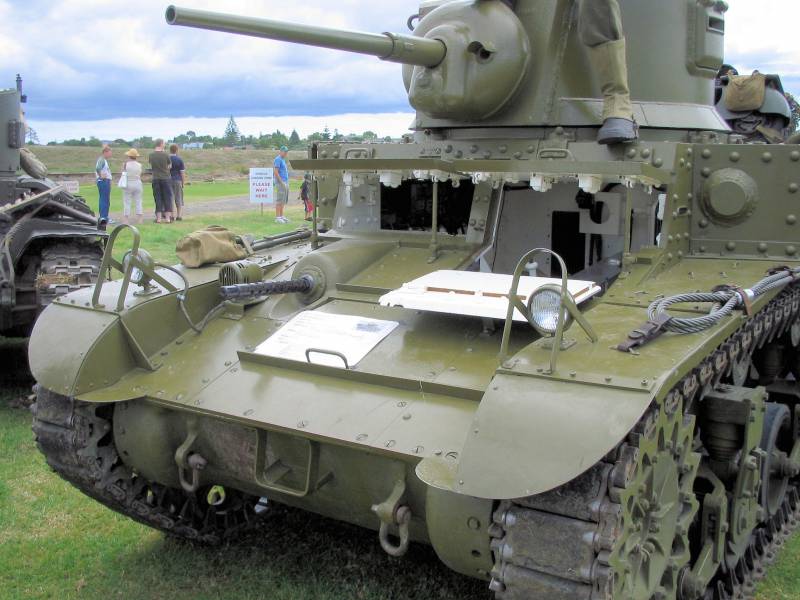
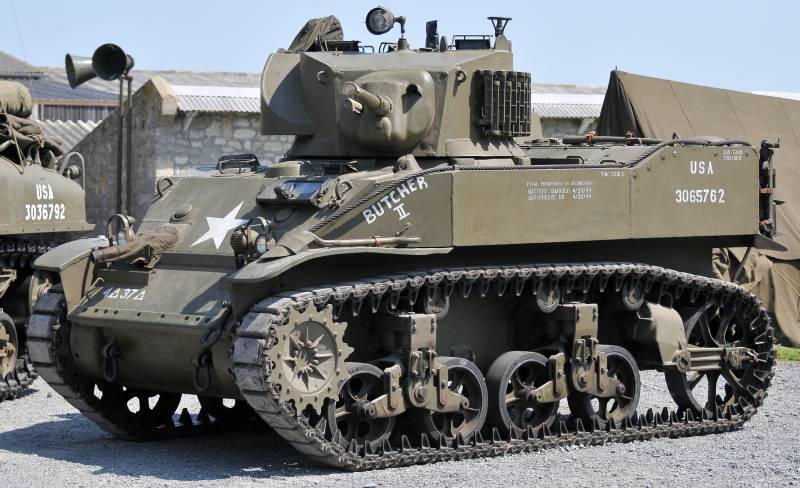
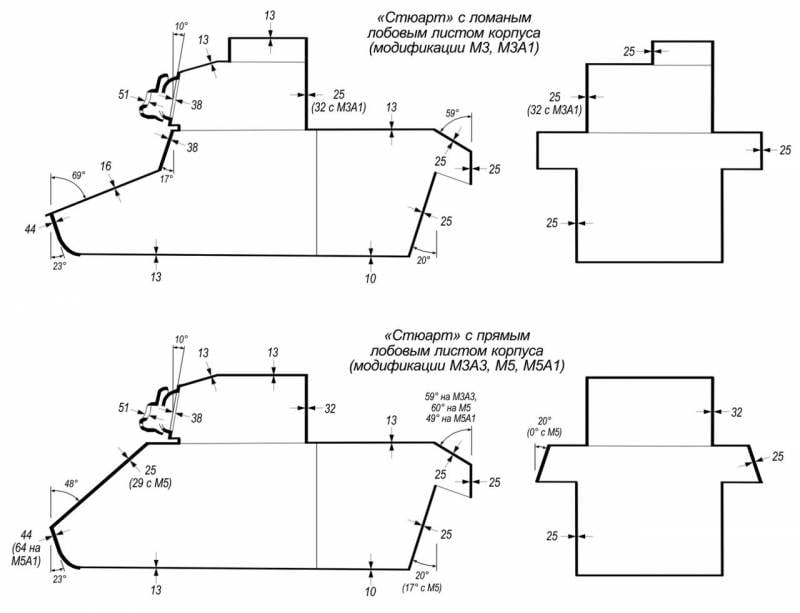
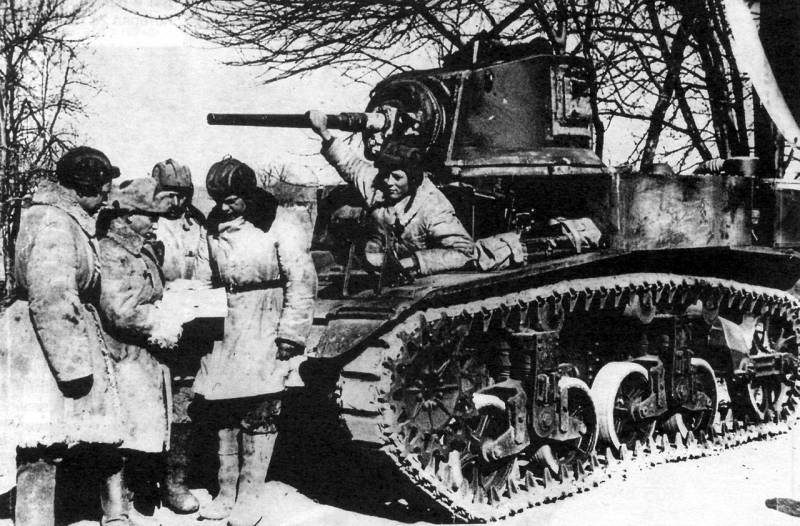
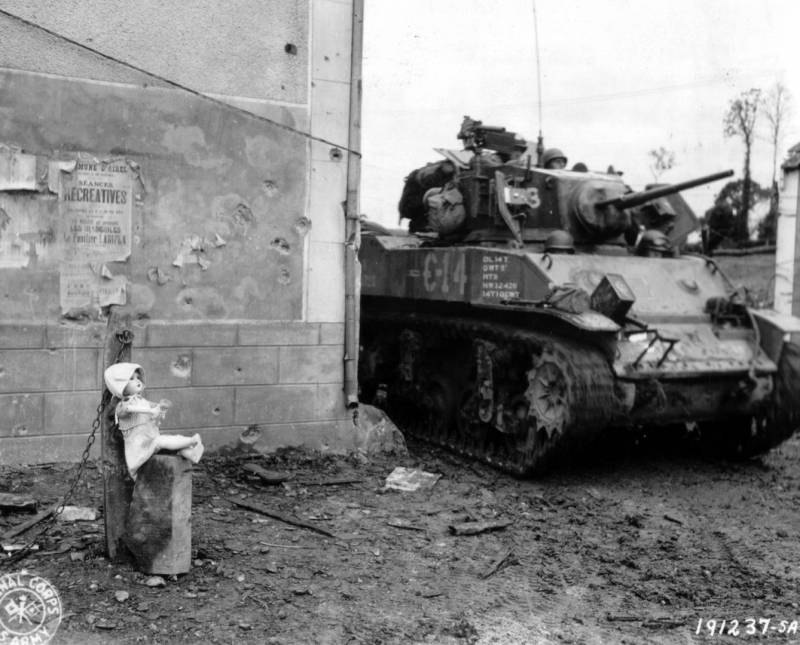
Information